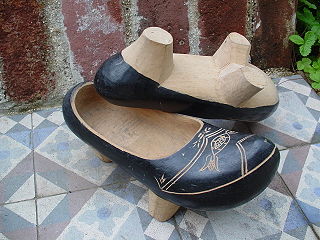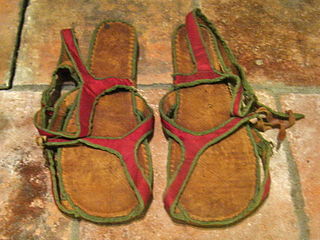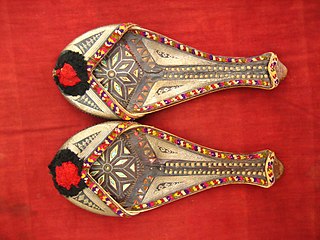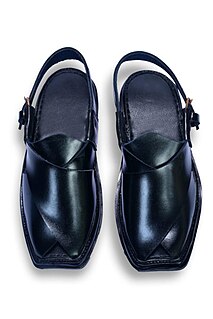 W
WAbaca slippers are made from dried abacá plants and leaves, as well as sometimes from dried pineapple plant leaves. Abaca slippers may be found in the Davao and Mindanao regions of the Philippines and are sold at many markets in the Philippines.
 W
WThe abarka (Basque), abarca or albarca (Spanish) is the traditional footwear in Pyrenees.
 W
WThe avarca is a type of sandal popular in the Balearic Islands (Spain), especially Menorca. The shoes are made using a leather upper and a rubber sole. Avarca is a traditional sandal originally developed in Menorca in the Balearic Islands. They were originally made from a leather upper and with the sole made from a recycled car tyre. Nowadays however the soles are made in the style of a car tire but from a purpose made mould. These are hard wearing and much lighter in weight than the original car tire sole. Only original avarca manufacturers are granted with the label "Avarca de Menorca". This label is granted by local Government and guarantees that avarcas accomplishes minimum quality standards and avarcas are really manufactured in Menorca island.
 W
WBalgha, also spelled balga, belgha, or belga, are heelless slippers made from leather. They are part of traditional dress of the Muslim world and are related to Ancient Asia and the Chinese civilization.
 W
WBast shoes are shoes made primarily from bast — fiber taken from the bark of trees such as linden. They are a kind of basket, woven and fitted to the shape of a foot. Bast shoes are an obsolete traditional footwear of the forest areas of Northern Europe, formerly worn by poorer members of the Finnic peoples, Balts, Russians and Belarussians. They were easy to manufacture, but not durable. Similar shoes have also been made of strings of birchbark in more northern areas where bast is not readily available.
 W
WBiblical sandals, also called Tanakhi sandals and Khugistic sandals, are sandals consisting of a sole with two leather ligaments that pass across the foot, and one around the heel. The leather is usually brown or black. The Biblical sandals are the classic model of leading sandals manufacturers in Israel.
 W
WA Cantabrian albarca is a rustic wooden shoe in one piece, which has been used particularly by the peasants of Cantabria, northern Spain. In the neighbouring province of Asturias madreñas are still being widely used in rural areas, and have been used for millennia.
 W
WCiocia is an ancient and ethnic footwear of Latium (Lazio), Abruzzo, Molise, located in central Italy. Similar footwear can be found in Basilicata, Campania, Calabria, as well as the Balkans as the opanci.
 W
WClogs are a type of footwear made in part or completely from wood. Clogs are used worldwide and although the form may vary by culture, within a culture the form often remained unchanged for centuries.
 W
WTräskor are Swedish clogs typically made from alder, but sometimes birch or pine is used. Clogs are mainly manufactured in the southern part of the country, both as handicrafts and in factories. In 1905 there were 22 factories employing 241 people. One manufacturer is based in Vollsjö in Skåne, clogs for business use are therefore branded "Vollsjö slippers." Other notable manufacturers of clogs include Lotta, Troentorp and Swedish Hasbeens.
 W
WEpiscopal sandals, also known as the pontifical sandals, are a Roman Catholic pontifical vestment worn by bishops when celebrating liturgical functions according to the pre–Vatican II rubrics, for example a Tridentine Solemn Pontifical Mass.
 W
WEspadrilles, are casual, rope-soled, flat, but sometimes high-heeled shoes. They usually have a canvas or cotton fabric upper and a flexible sole made of esparto rope. The esparto rope sole is the defining characteristic of an espadrille; the uppers vary widely in style.
 W
WFurlane or friulane shoe-slippers, also known as Gondolier slippers, are casual, flat, but sometimes high-heeled shoes. They usually have a velvet fabric upper and a flexible sole made of rubber. The rubber sole is the defining characteristic of a pair of furlanes; the uppers vary widely in style.
 W
WA galesh (گالش) is a traditional footwear of Iran.
 W
WGiveh or Givah is a kind of soft, comfortable, durable and handmade shoe that is common in several parts of Iran especially in rural and mountainous areas of Kermanshah Province. The production centers of Giveh are the provinces of Yazd and Kermanshah in Iran.
 W
WThe Haferlschuh is the traditional Bavarian shoe. It was designed originally as a work shoe for alpine terrain, but it can now be worn in a more general setting. In Bavaria it may also be called a Bundschuh. In Austria, it is known as a Schützenschuh.
 W
WHnyat-phanat is a Burmese traditional sandal, similar to flip-flops. Although it refers to almost any sandal worn by the people of Myanmar, it is mostly used to refer to the traditional Mandalay velvet slippers that originate in Upper Burma (Myanmar).
Huaraches are a type of Mexican sandal, Pre-Columbian in origin.
 W
WHwa are a type of traditional Korean boot, which, along with yi (이), is a subdivision of Korean shoes. The yi refers to all kind of shoes that do not go up to ankle. Hwa are usually made of leather, and artisans who make the shoes are called hwajang (화장). It was originally worn by northern kingdoms of Korea. The horse-riding cultures of the North appear to have typically worn leather boots (hwa), while the farmers of the South wore shoes of leather or straw (hye). Different types of boots were worn by military and civil officials.
 W
WJorabs are multicolored socks with intricate patterns, knitted from the toe-up. They are usually worn in such a way as to display rich decoration.
 W
WA moccasin is a shoe, made of deerskin or other soft leather, consisting of a sole and sides made of one piece of leather, stitched together at the top, and sometimes with a vamp. The sole is soft and flexible and the upper part often is adorned with embroidery or beading. Though sometimes worn inside, it is chiefly intended for outdoor use. Historically, it is the footwear of many indigenous people of North America; moreover, hunters, traders, and European settlers wore them. Etymologically, the moccasin derives from the Algonquian language Powhatan word makasin, and from the Proto-Algonquian word *maxkeseni (shoe).
 W
WMojari or Khussa or Saleem Shahi's is a style of handcrafted footwear produced in South Asia. They are traditionally made by artisans mostly using tanned leather. The uppers are made of one piece of leather or textile embroidered and embellished with brass nails, cowry shells, mirrors, bells and ceramic beads. Even the bonding from the upper to the sole is done by cotton thread that is not only eco-friendly but also enmeshes the leather fibers with great strength. Some product range also uses bright and ornate threads.
 W
WMukluks or kamik are a soft boot, traditionally made of reindeer (caribou) skin or sealskin, and worn by Arctic aboriginal people, including the Inuit, Iñupiat, and Yupik.
 W
WKhussa, is a style of South Asian handcrafted footwear produced in Punjab Pakistan.
 W
WOpanci are traditional peasant shoes worn in Southeastern Europe. The attributes of the opanci are a construction of leather, lack of laces, durable, and various endings on toes. In Serbia, the design of the horn-like ending on toes indicates the region of origin. The opanci are considered a national symbol of Serbia, and the traditional peasant footwear for people in the Balkan region.
 W
WThe Papal shoes were the red leather outdoor shoes worn by the Pope. They should not be confused with the indoor Papal slippers or the Episcopal sandals, which are the liturgical footwear proper to all ordained Catholic bishops of the Latin Rite.
 W
WPeshawari Chappal is a traditional footwear of Pakistan, worn especially by Pashtuns in the Khyber Pakhtunkhwa region. The shoe takes its name from the city of Peshawar, where it originates from. While chappal is the word for flip-flops, or sandals in Urdu. People in Peshawar -- the locals -- call the Peshawari Chappal Tsaple. Peshawari Chappal is worn by men casually or formally, usually with the Shalwar Kameez dress. Because of its comfort, it is used in place of sandal or slipper in Pakistan.
 W
WRope-soled shoes have soles made from rope or rope fibres. They were formerly a cheap, disposable, hand-made item. However, the widely made espadrille comes in many styles and can include expensive fashion items.
 W
WA snowshoe is footwear for walking over snow. Snowshoes work by distributing the weight of the person over a larger area so that the person's foot does not sink completely into the snow, a quality called "flotation". Snowshoeing is a form of hiking.
 W
WValenki are traditional Russian winter footwear, essentially felt boots: the name valenok literally means "made by felting". Valenki are made of wool felt. They are not water-resistant, and are often worn with galoshes to keep water out and protect the soles from wear and tear. Valenki were once the footwear of choice for many Russians, but in the second half of the 20th century they lost most of their appeal in cities, due to their association with rustic dress.
 W
WWaraji (草鞋) are sandals made from straw rope that in the past were the standard footwear of the common people in Japan.